This article will help you get familiarized with one of the most important aspects of deck building – how-to tech your deck! In the paragraphs below we will take a detailed look into what tech cards are and how to differentiate one from the other, how they fit into deck archetypes and how to make the best choice for your deck and the current metagame!
Glossary
First things first – we have to establish a common ground to work from. Before we can take a look at tech cards and how to use them, we must examine what a tech card actually is and give some definitions that we can follow along.
In order to do that, first we must realize that there are different categories of cards that fit in the broad definition of “tech”. We all know the classics such as Acidic Swamp Ooze, Crazed Alchemist or Mind Control Tech, but looking at the differences in the utility they provide can teach us a lot about the design of such cards. For instance, we can see that some of them, such as Hungry Crab, directly destroy their target when a very specific condition is met. Let’s be clear, direct removal is an extremely powerful effect and is usually very hard to come by for most classes and it is never cheap. Of course, we do have a huge opportunity cost to meet on the other end of the effect – if it doesn’t hit the card it’s made to hit, the poor little crab does next to nothing and turns from a borderline overpowered card to a barely playable one in an instant. We can see this design on many tech cards and in the future, we will be referring to those as hate cards.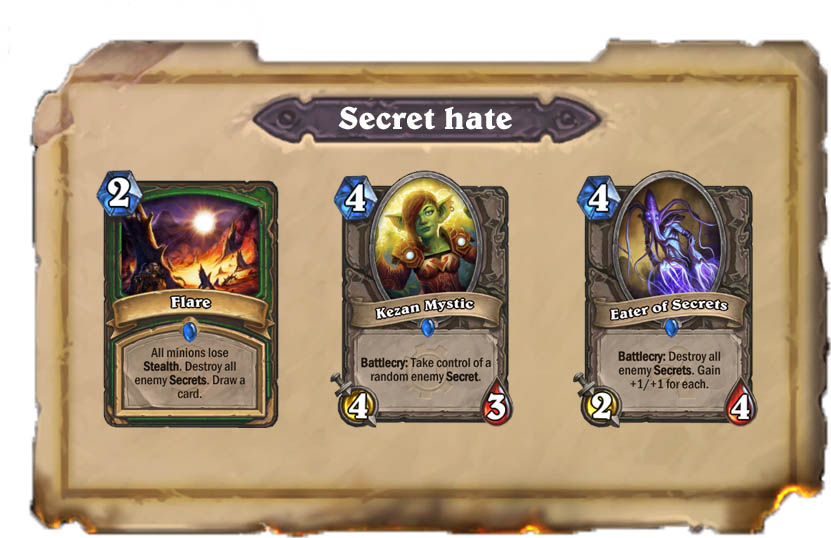
On the other hand, we see something similar but a lot more flexible in Crazed Alchemist. The card does not have to meet very specific requirements in order for the effect to go off, but while useful it’s not nearly as powerful. It does shine against 0-attack minions because it outright kills them, which turns it into a hate card in those specific scenarios, however it does have the added benefit of being flexible – the opportunity cost you pay for putting it in your deck is greatly reduced because it has other applications at a lower power level. For cards such as the Scientist we have to judge each one individually – it can be played as a regular tech card, however when we most often see it in the metagame is when Doomsayer is very popular and aggro decks want to have a very specific answer against a this very specific threat to their game plan. In that sense, Crazed Alchemist functions like a hate card (another example here would be Stampeding Kodo – what is usually generalistic tech towards aggressive decks has become a staple response for midrange decks to Finja, the Flying Star). Lastly, we have cards such as Mind Control Tech that are tech cards which mostly aim to punish play styles and opponent’s behavior patterns. This is what we will refer to as tech cards for the purposes of this article.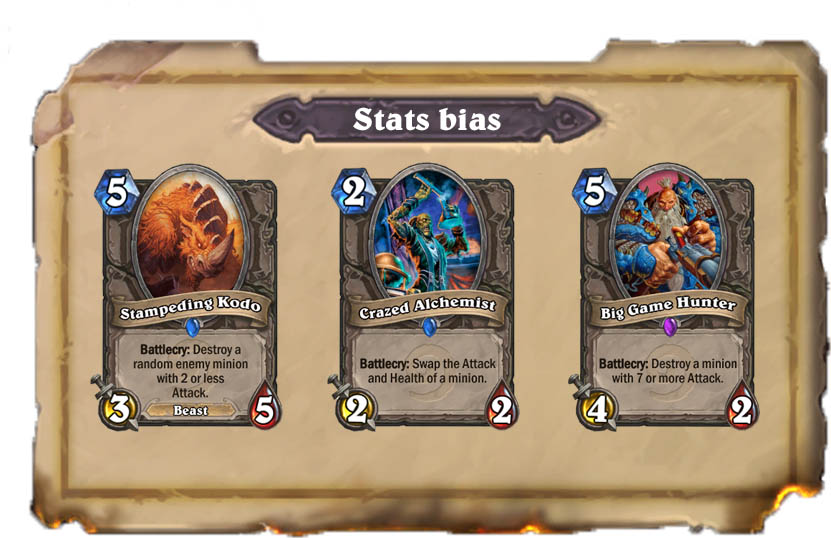
Since this is the glossary, here are “official” definitions for the different terms we use:
- Hate cards – provide a very powerful effect against a specific niche of cards at a very big opportunity cost. They create enormous swings in the game when activated successfully but only look for very specific targets.
- Tech cards – punish behaviour patterns by the opponent. They require the player to meet less strict conditions and lower the opportunity cost by providing small benefit even when their condition has not been met to it’s full extent and often have the ability to scale alongside it.
- Flex cards – often times in deck building, certain decks will have a large number of their spots locked on certain “core” cards and have room to be “teched”. However, it is not always the case that tech cards are included. Those are the deck’s flex slots and as such, cards that go there are the deck’s flex cards, however that does not necessarily make them tech (though you could *say* that you are teching your deck, in the sense that by using different cards you are also inadvertently altering your strategy, lightly or not).
- Teching – the act of putting specific cards in your deck in order to cover a weakness or address a specific problems. Both hate and tech cards can be used to modify a deck against the meta (or sometimes a single matchup) and teching is the process of including those cards over others that are usually better in a general sense.
- Opportunity cost – the extent to which the player is punished for including this card in their deck. A high opportunity cost means that the card has a binary behaviour – very strong when it hits the specific target it’s looking for and very bad when it fails to do so. The vice versa is true for a low opportunity cost card. (Opportunity Cost is most often expressed in low stats, but is also seen in high mana costs and most devastatingly, a combination of the two. Generally it can be expressed as a “loss in tempo”.)”
Complete Rundown of Hate Cards
Now that we have a strict definition of what the differences between hate and tech cards are and which are neither, we can take a closer look at exactly which cards we are talking about. They are separated in two categories – neutral cards and class cards. The list is just below, but I want to make some observations first – to start off, we can see that most hate cards are neutral and only a tiny amount belong to a class. This is exacerbated further if we take a look at the broader picture of tech choices, but we won’t look at all of those right now. The second thing we see is that a big chunk of them are cheap, costing three mana or less (true for both neutral and class cards), meaning they can slot with relative ease into most decks without disrupting their flow too much. Lastly, it’s rather interesting to see is that there is redundancy and variance between them – the exact same effect is sometimes offered at different stat lines (and costed appropriately for them), which allows for different deck archetypes to accommodate them better depending on their preferred style of play. By the end of this article we will ask the question whether or not the things we observe here are good and/or healthy for the game, but for now just keep them in mind as you browse through Hearthstone’s hate cards.
Neutral Cards
- Acidic Swamp Ooze
- Bloodsail Corsair
- Hungry Crab
- Crazed Alchemist
- Golakka Crawler
- Blood Knight
- Gluttonous Ooze
- Ironbeak Owl
- Mindbreaker
- Light's Champion
- Toxic Sewer Ooze
- Eater of Secrets
- Kezan Mystic
- Kooky Chemist
- Spellbreaker
- Big Game Hunter
- Harrison Jones
- Hemet Nesingwary
- Stampeding Kodo
- Streetwise Investigator
- Defias Cleaner
- Skulking Geist
- The Black Knight
- Rend Blackhand
Class Cards
- Keeper of the Grove
- Flare
- Silence
- Mass Dispel
- Kabal Songstealer
- Sabotage
- Earth Shock
- Sacrificial Pact
And there are, of course, many cards that can be debated whether or not they are hate, tech or simply beneficial/disruptive to your opponent that are hard to classify. An excellent example of this is the Priest Quest, Awaken the Makers – typically it’s your usual, build-around card for control decks, but if you consider the case of Alexstrasza, you could use it as a “tech” against Mage decks who use the scary dragon to get you into Fireball Fireball Frostbolt range, since it is a perfect answer to their strategy. In that sense, it’s a tech card, even though nobody usually thinks about it as such.
Another example that comes to mind are the disruptive minions such as Gnomeferatu and Dirty Rat (and Ancestor's Call in the same vein). Here we have to ask the bigger question: “Are disruptive cards hate or tech cards?” I don’t believe so, just like we previously established that removal is not “creature hate” or “tech against creatures”, because this is way too broad of a description and does not fit within our definition for tech cards. However, consider this – Dirty Rat is a close as it gets towards “hate for Battlecry” – it fits the criteria of targeting something very specific with a big opportunity cost margin (big payoff when it hits, big downside when it doesn’t) and is played by a small number of decks exactly as any other tech card.
I’d say there is plenty of room for debate on the fringe cases like that, but for the purposes of this article I will treat Dirty Rat & Co. as if they are not tech cards. The same holds true for cards such as Loatheb, Mana Wraith, Nerub'ar Weblord and Nerubian Unraveler, which although disruptive to your opponent, serve more toward advancing your own position rather than dealing with specific threats from the enemy, not to mention their effect is only temporary. The reason Silence effects are included is because they serve as hate primarily toward the Deathrattle mechanic, but also hit Auras, Buffs, etc.
Tech Cards
In this section we will take a look at various cards that fall better within our “tech” definition. These cards function by punishing specific behavior patterns by the opponent, in a way as if they are hate cards for archetypes. That’s too broad of a description so we don’t call them that, but we can see it more clearly when we look at specific examples. The tricky part about identifying tech cards is that they come in too many shapes and forms and often times cards can behave like tech without actually being such. Conversely, cards that have all the properties of tech can behave like normal cards because of the nature of their gameplay. One example for this is Hunter’s Unleash the Hounds – although it’s a card that is meant to punish opponents who go wide on the board, it is so good in most Hunter decks that it approaches auto-include status and is present in decks even when they wouldn’t get the most benefit out of it. It’s still not run when a big part of the meta consists of decks that don’t play very much on the board (which is an extremely rare meta to be sure), hence why it’s a tech card, but those situations do arise and we have to be able to properly assess which cards are in the deck simply because they are good cards for that deck and which ones are teched in to deal with specific problems.
Examples
- Tinkmaster Overspark
- Mind Control Tech
- Unleash the Hounds/Protect the King!/Spreading Plague
- Tanaris Hogchopper/Spiked Hogrider/Leatherclad Hogleader
- Mountainfire Armor/Skelemancer
- Aldor Peacekeeper
- Frost Nova
- Alexstrasza
- etc.
It is interesting to observe that a good portion of the tech cards are oriented toward punishing decks that extent wide on the board, suggesting that most tech cards are more oriented toward the controlling play style rather than the aggressive one. To an extent that does make sense, given that tech cards are reactive in nature, which naturally suggests control, however we see enough examples of aggro-compatible tech that we shouldn’t be worried about any real bias. Sometimes tech cards can not only support aggression but straight up enable it. If we look at Alexstrasza we can see a classic example for this. She was originally a tech card against decks that are based around staying healthy and/or generating tons of armor (originally she also destroyed the target player’s armor and there was nothing one could do to prevent being set down to 15 health), allowing for games against those relatively non-interactive decks to be closed out. Eventually of course, some Mage players started to realize that you can fit 15 points of burn into 10 mana and decided that instead of teching in Alex, they can straight up base their strategy around her effect and simply use the class’ tools to do nothing until they played her.
The key here is to show with an example that although a card can have a deck built around it, that does not exclude it from being a tech card. Previously we looked at how Awaken the Makers can be tech against Alexstrasza and we can further expand our analogy if we look at something like Mountainfire Armor – the card’s mechanic aims to punish decks that primarily play aggressively on the board and rely on minion trading (a.k.a. the Zoo style decks) but falls flat when facing strong defensive minions that it has to be traded into (Tar Creeper, Sludge Belcher). That does not prohibit it from being a cornerstone of the relatively new N’Zoth Warrior, which uses it to generate tons of armor and stay healthy as it shuffles N'Zoth, The Corruptor around with Dead Man's Hand.
I think it’s worth noting that all Secrets should probably be considered as tech cards. They fit very well in our definition for what a tech card is and although particular secrets approach auto-include status in some decks, in general they are used to punish certain plays from the opponent. More powerful secrets such as Counterspell can be treated as hate cards, however (like all secrets) they can be leveraged by the opponent and be “forced” to miss their intended target through smart play.
Properly identifying which cards fall into what category is an important skill to develop, both in terms of deck building and when it comes to playing a deck you found online. To better prepare you for the task, read along to find all about the different approaches to modifying your deck and adapting it to the current metagame.
Teching Your Deck
When it comes to including tech cards, we find that very often there is more than one option available for a given scenario, especially when concerning cases where more than a niche subsection of the cards are concerned. The best example for this is regarding Silence minions, which come in many shapes and forms across multiple mana costs, that share the exact same effect. The difference between them is the varying opportunity cost you have to play for each one and each style of deck is prepared to pay different costs.
However, in most cases the tech options you consider for your deck will be based around two things – what’s necessary and what’s available. The former asks the question “What problems are you facing?” and the latter presents you with a card or subset of cards that say “These are all the possible answers to your problem”. Generally, if you are facing very specific problems that are widely popular in the metagame (such as powerful cards with the “Pirate” tribe) you chose cards that hate on the problem and if you want an edge against another archetype or a set of popular decks that follow a similar strategy (a.k.a. play pattern) you chose tech cards that work well against them:
Choosing Hate Cards
We know that we want to use hate cards when there is a very specific problem we need to deal with, but choosing the right answer is not always straightforward. The most basic example of this is the one previously given, regarding Silence options, especially when dealing with the exact same effect. In the neutral card pool, both Ironbeak Owl and Spellbreaker do the same thing, what differs is their mana cost and their stats. In other words, the “Silence a minion” text is offered at different opportunity costs. The reason this is happening is because different decks are going to want a different option, based on their play style. Fast aggressive decks want their hate cards to be as cheap as possible so that they can be weaved together with other cards on the earlier turns, because they are looking to close out the game before they can even be able to pay for a more expensive version (Owl used to cost only 2 mana back in the day).
Following the same “finish the game” mentality, they do not care a lot about what stats the minion has, that’s why they don’t mind playing such a poorly statted creature (1-health minions are notoriously bad in Hearthstone, because they die to virtually anything, including for free at the hand of some hero powers). In that sense, the deck is prepared to pay a huge opportunity cost for including Ironbeak Owl – if they can’t capitalize on the effect, then it is essentially a dead card. As a counter example, slower controlling decks want the exact opposite – their cards must pack a punch and be able to stand on their own whenever possible. They are prepared to pay more mana in order to gain much needed board presence and are built with the late game in mid. Those decks usually react to what’s happening to them in the earlier stages of the game and would much prefer the lower opportunity cost of Spellbreaker, which does not suffer such a huge downgrade of stats for its mana cost (in this example, it is in fact lower than that of Owl, but out of context Spellbreaker’s cost approaches medium levels).
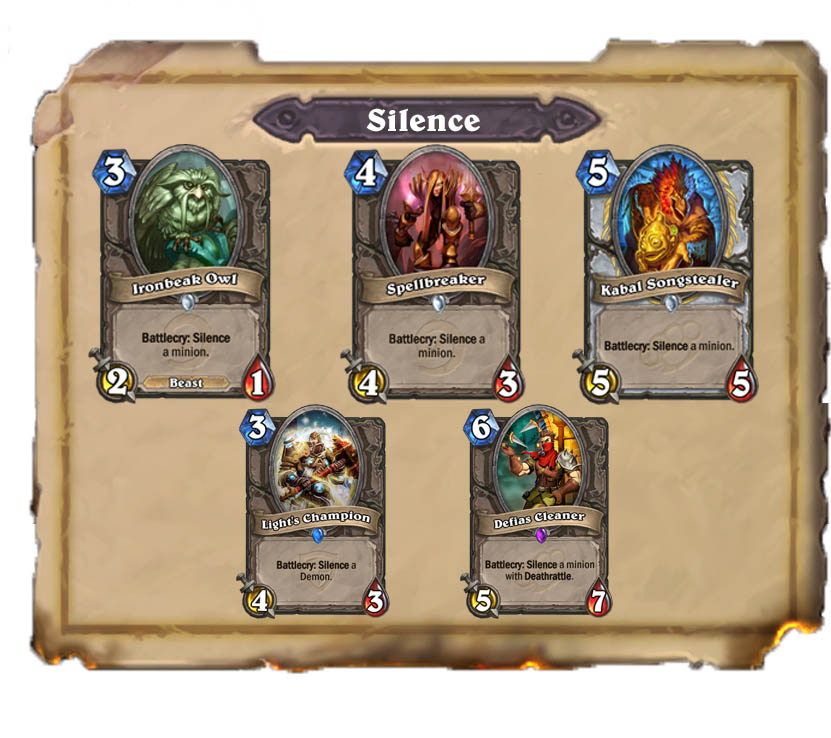 We talk a lot about opportunity costs because they are essential to understand and leverage, however we must take all factors into consideration when determining which hate cards to play and why. When looking at the metagame we want to prepare for, we must make the following considerations:
We talk a lot about opportunity costs because they are essential to understand and leverage, however we must take all factors into consideration when determining which hate cards to play and why. When looking at the metagame we want to prepare for, we must make the following considerations:
- Is there a narrow subset of cards that are very popular and/or over-represented in the meta? (The reason to ask this question is that no matter how strong something is, if we don’t see it often then having hate for it in our deck is going to be actively detrimental most of the time and will actually negatively impact the winrate of our own deck.)
- Is there a narrow subset of cards that are for our deck in the meta? (After we have identified whether something justifies including hate in our deck, we have to check if it warrants it.)
- Is there an answer for the problematic cards in the available card pool? (We then need to check if there is available hate in the format or if we have to look for a different approach and consider tech options.)
- Does that answer come at a low, medium or high opportunity cost and what are we prepared to pay? (If there are multiple options, we choose the best one for our deck’s play style, however in the case of a more narrow pool of answers we have to think whether or not we can include the hate card in our deck, even if there is one.)
- How much do we gain from including it in our deck? (After identifying that our deck can support it, we have to ask ourselves if the whole thing is worth it – sometimes there is less gain in answering a problem than doing something entirely different altogether, though most hate cards are designed in a way that they create a truly massive power swing.)
After we have gone through this quick iterative thought process, we should be able to reliably identify which hate cards are good for our deck. Some of them are self-explanatory, but others require a bit more nuance. For instance, it’s clear that whenever cards with the “Pirate” tribal tag are strong, Golakka Crawler is not simply the best, but the only direct answer. The same is true for Murlocs with Hungry Crab, etc. However, dealing with something like Taunt can be entirely different – fast decks will play a Silence effect to remove the obstacle and go right past it on their way to ending the game, while slower decks might prefer something like The Black Knight, which will provide a much more meaningful swing of power on the board from one player to the other. In the same example still, a slower yet aggressive deck might prefer a minion along the lines of Rend Blackhand if the Taunt minion happens to be legendary (such as The Lich King, who was in most decks at the start of KFT), which threatens to connect for massive damage when left unchecked.
Choosing Tech Cards
In the realm of tech cards, things are a slightly different but not drastically so. When considering tech cards for our deck, we have to follow a similar thought process, however the focus shifts from cards that beat us to strategies that beat us:
- What is the most represented archetype (aggro, midrange, control, combo) in the meta? (We must identify what the field looks like and determine where we are positioned within it.)
- If we are unfavored against it, is there tech available to us to make it as favorable as possible with as few cards as possible? (Adapting our deck to improve a bad matchup is good, but at some point teching too heavily will start to disrupt the consistency with which you can execute your own game plan, which is much more important.)
- If it is the same as the one we are playing, are there tech cards that can improve our matchup against it without sacrificing power elsewhere? (Very similar line of thought – teching against something you are not necessarily unfavored against can push you even further ahead.)
- From the pool of available answers, which one is best suited for our deck archetype? (Same as looking for a good compromise between opportunity cost and payoff power level, we want to make sure that playing tech cards doesn’t disrupt our primary game plan.)
- How reliable is that answer? Can my opponent negate it’s strengths by consistently playing around it? (We want our tech card to function when it’s supposed to function – a key property we identified about tech cards is that they are less “hit or miss” that hate cards and typically scale alongside the problem they are meant to answer. The key here is identifying how good the average outcome for our tech card is and judging its power level that way.)
A notable example of teching to the needs of the metagame is the inclusion of Tar Creeper in aggressive decks – the minion provides virtually no pressure, but its defensive best-in-class board presence makes it hard for the opposing minion-based deck to trade with your minions. However in the case of something like Aggro Druid, we don’t see Spreading Plague being used because its cost is way too high, even though it would be an almost instant win against a deck of similar play style. Following these steps will help ensure you keeps yourself in check when teching your deck against the field. An example of people “overteching” and focusing too much on answering something is when they play Skulking Geist in almost every deck out of the fear of Jade Druid, even if their deck is not built to support such a low tempo card as a 6 mana 4/6. Even though the deck’s ability to scale infinitely does beat a lot of strategies, there are 4 other top decks in the meta that are a lot more represented which are not hurt by Geist enough that it would stop them, meaning you are a lot more likely to queue against one of them on ladder rather than against Jade Druid. Matchups where paying 6 mana for Geist’s body is bad that happen more often will negatively impact your win rate rather than boost it.
Hopefully by following these guidelines you will have learned to better pick hate and tech cards for your deck and against the metagame, so you can be better prepared next time you go on ladder and gain that crucial edge over your opponents.
Closing statements
In the end, I’d like to take a look at the current hate and tech card environment and discuss how it’s structured, its pros and cons and where we can go with it in the future.
Tech Card Design Philosophy
I will start by making some observations about the pool of tech cards we have. First off, they seems to be condensed around certain card rarities – they are predominantly rare and epic, with some decent amount being common and a few being legendary. What’s troubling is that there appears to be a lack of consistency in how effects are distributed among rarities in some cases – why is Golakka Crawler a rare and Hungry Crab an epic? This could speak of two things – one of the effects is deemed necessary to be more widely available (it is a fact that Hearthstone has an economy problem and most new players can’t afford luxurious epics and legendaries such as tech cards); or there has been a shift in the philosophy behind the design of tech cards and we are going to see similar effects put at rare going forward.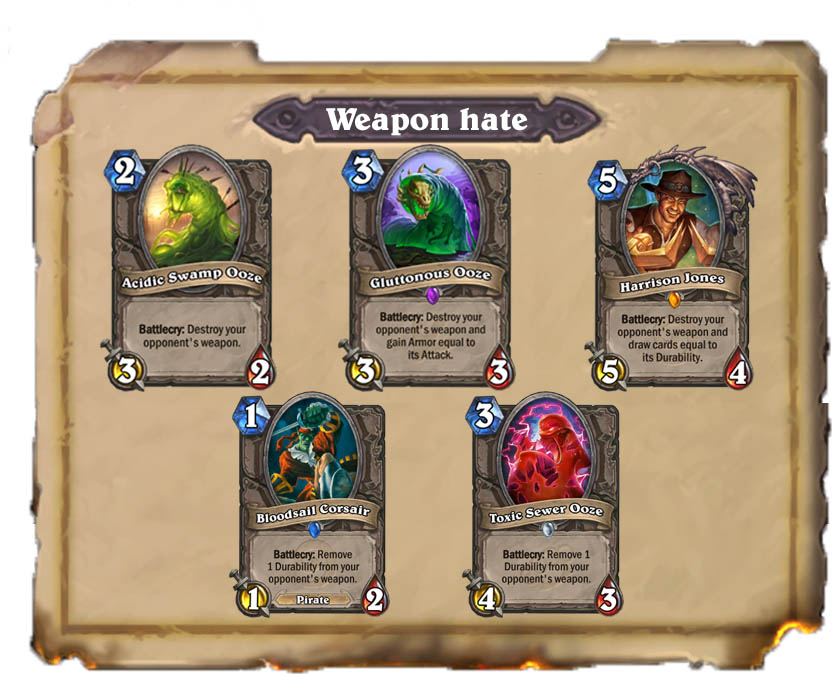
However in general, we have to ask those exact questions – do we need to lock our tech cards behind different rarities? I think it depends on how it’s done. If we look at the weapon destruction line, we can see very clear escalation in power level as we move up through the various dust costs – everybody gets Acidic Swamp Ooze for free, but it doesn’t do anything else than its base effect. Recently we had Gluttonous Ooze introduced at epic which on top of doing its job also gives the player a health boost. Lastly, of course, there is Harrison Jones, who on top of destroying the weapon also gives card advantage, which is extremely powerful. The real question to the designers here is the following – is this something we need? I think it has a lot of benefits, but on the other hand we are locking a big portion of the player base from accessing good tech cards.
What’s curious about the legendary tech cards in particular (Harrison Jones, Hemet Nesingwary, The Black Knight, Rend Blackhand) is that they appear to have as equally powerful versions of answers (through the “destroy” keyword) as most of their corresponding epic and rare counterparts, but their opportunity costs is raised very high by the extremely poor stat distribution they received. While destroying something is very strong, we also see tribal and weapon destruction on cards from the rest of the spectrum that are not given nearly as high of an opportunity cost.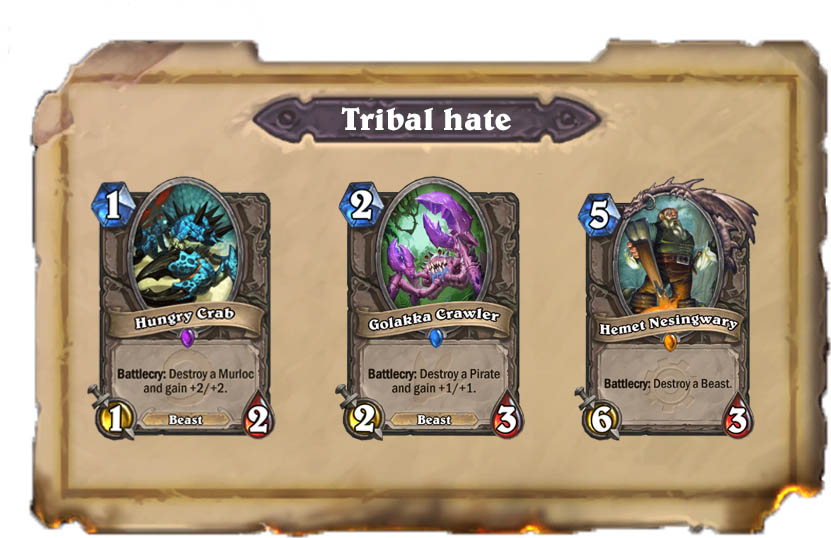
This might be part of a larger pattern – the more expensive the tech card, the more it is punished in its stat distribution when it’s a minion. There are exceptions, of course, but the general pattern holds true. One can’t help but wonder why that is, especially given that most of the costly tech cards can’t even be played by a good chunk of the decks out there. It could be that higher costs and stats allow for finer and more granular control, whereas cheap minions with a few stats here and there don’t offer a lot of tuning potential, however most of the expensive tech cards are so much on the side of caution that they are barely playable, if at all.
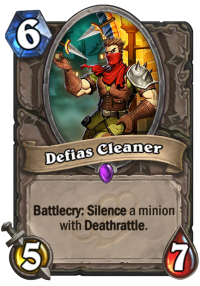
Of course, it could simply be that the situation hasn’t arisen yet where Defias Cleaner would make it as a part of the metagame, but it’s very unlikely. The question we can ask here is whether or not we need such cards – preemptive safety valves with no real use, in case something gets out of control later down the line. The problem with cards like Cleaner or Streetwise Investigator is that they are so bad, even if something like a problematic Stealth card were to slip past Final Design, Investigator wouldn’t even be a good answer. With only a handful of cards coming out each set, do we really want more Defias Cleaners out there? It’s basically a worse Silence card because it can only target minions with Deathrattle (which all other Silence cards can do as well, in addition to being free to target whatever they want) and it’s in one of the set’s neutral epic card slots. It’s a nice thing to not show up often in Arena, but at the end of the day this is not an epic card players want to be opening in their packs.
The Future of Tech Cards
I don’t know what the future of tech holds or how the developers want to continue designing new cards, but I know what I’d like to see. Hopefully tech can continue to be centered around easily accessible rarities, such as and rare and common and if we see epic or legendary cards they follow the weapon destruction example. More importantly, it would be great if tech legendaries stop being bad. Opening a legendary card from a pack is one of the best feelings for a hearthstone player and when that has a niche application, it can sit in their collection for months on end until the right metagame comes along. This makes them hard to keep for players without a full collection and when it comes to crafting, most people can’t justify spending 1600 dust on a tech card.
I’d like to see Hearthstone’s tech card structure redesigned to have a more clear identity within the game that’s better expressed through consistency between the various cards. It would be nice if there were more diverse answers introduced – not every question should necessarily have a specific niche answer, but most of the game’s tech cards are focused on tribal or and various renditions of the Silence effect. Speaking of which, most of the hate cards are way too swingy and tend to often decide games by themselves with a simple check of whether they are drawn in time to answer what they are meant to or not. We need more cards like Skulking Geist, which alleviate a problem but leave room both for the opponent to react and for you to capitalize on the advantage.
If you made it this far – great, you now have a better understanding of tech cards, what they are and how to use them effectively in order to gain an edge in the ever shifting meta.

Amazing article.
I take special interest in it since a few days ago I built a kinda-control oriented hunter deck and so far it got me a decent rank for a meme deck. Can’t say it’s a really good result but originally I made it to piss of people running top decks and for some reason it kinda worked. I added crabs, stampeding kodo, flare and a couple of other cards. Killing shaku and finja with the kodo really fills my heart with joy.
Summary: Check the top tier decks, and add a bit of flavor to your deck by teching vs them. In some cases it ruins the flow of your game, but when it doesn’t… oh boy is it worth it. Overall I think it enriches the game.
P,S – take the words of a guy who put Eater of Secrets in a pirate warrior deck.